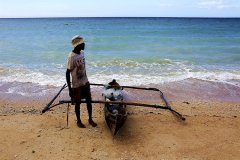Output of Costa Rican coffee beans washing Costa Rican flavor
For professional baristas, please follow the coffee workshop (Wechat official account cafe_style)
Costa Rica's production is small, with an annual output of about 110000 tons, ranking seventh in Central and South America. Costa Rica is dominated by recent coffee varieties, such as Kaddura, Kaduai, New World, etc., while the ancient bourbon and Tibica are rare. There are also many varieties in the territory, the most famous is the bourbon variety Vera Saatchi, a variety of elegant flavor, Brazil has also been introduced and planted, has won a prize. In addition, Costa Rican research institutions have spared no effort to improve the mixed-race Katimo, trying to reduce the stout bean pedigree and enhance the Arabica flavor of Katimo, which has been exported to Asia for trial cultivation in recent years.
The most famous large planting area in the country is Tarrazu, which is near the capital San Jose. Tara Zhu producing area has the highest average latitude and excellent climate and soil conditions, which makes Tarazhu the most famous and generally recognized coffee producing area in Costa Rica. Sanshui River (Tres Rios) is a famous small producing area in Tarazhu producing area. Boutique Coffee the most famous Costa Rican single estate coffee in the world is the La Minita estate in Tarazu District, which produces only 160000 pounds a year.
St. Roman treatment plant, the use of water washing treatment, with a strong flavor. Coffee cherries are well-known for their rich and solid taste. Coffee cherries are hand-selected by coffee growers to remove overripe or immature cherries, and then production processing is carried out. 3 disc aagaarde peeling machine is used to remove the skin and pulp, and then the machine is divided into three grades according to the density of coffee beans. Grade 1 and 2 raw beans are fermented separately, while grade 3 is low-quality raw beans. The raw beans were fermented in a cool place for about 24 Murray for 36 hours. After fermentation, the raw beans were washed and graded again according to the density on the cleaning channel, and then the raw beans were randomly soaked in clean water overnight. After the processed coffee has been roasted, the bitter sweet chocolate flavor is as thick and sweet as cream sugar, with low-key wine acidity and aroma, and the fruit sweetness of chocolate beans is forgettable. Costa Rican volcanic terrain with fertile volcanic ash, mild and suitable temperature, and stable and abundant rainfall is one of the reasons why coffee has become one of the main agricultural products in Costa Rica. The seven major producing areas are: Tarrzu, Tres Rios, Orosi, Central Valley, West Valley, Turrialba and Brunca.
The best coffee in Costa Rica seems to come from small processing plants, spread across several major coffee producing areas, including Tarazu and the western valley. This so-called coffee revolution originated 15 years ago and has greatly changed the way bean baking experts and importers think about Costa Rican coffee. Take the processing plant as the center, collect coffee beans from the surrounding small farms for processing, most of these farms are made up of small communities or families, growing coffee on their own small farms or land, and all the coffee is treated and dried by a small processing plant. The quality and flavor of Royal Coffee are very unique, which is largely due to the cooperation between coffee producers and us.
Costa Rican coffee cultivation was introduced by Cuba in 1779 and exported for the first time in 1820. There are about 32000 coffee farmers, with an average planting area of less than one hectare (10000 hectares) per farmer. Costa Rica has a population of 41 billion (2006), with a coffee planting area of 82500 hectares and an annual production of 1.7 million bags (60kgs per bag). The annual domestic consumption is 380000 bags, with an average annual national consumption of 5.5kgs, which is higher than that of Japan (consumption 4kgs). At present, Taiwanese are only slightly higher than 1kg.
Costa Rica is the country where coffee was first introduced into Central America. It has a long history and has a complete coffee organization from production to marketing system. Because it is located in the Central American Gorge, there are many volcanoes, it has the natural advantages of sunshine and land, and the climate is reconciled by Pacific and Atlantic currents and sea breezes at the same time, the coffee produced has the characteristics of local micro-climate and soil conditions, in terms of quality and quantity, Costa Rican coffee has always been recognized by the world, and has been rated as one of the world-class high-quality coffee. Costa Rican coffee has been cultivated for two hundred years. It was first planted on the slopes of the Poas and Barva volcanoes, today known as the Central Valley (Central Valley). The seven main coffee producing areas are distributed from northwest to southeast, along with the inland central plateau.
Factory name: Qianjie Cafe location: Dongshankou Yandun Road, Yuexiu District, Guangzhou City
Manufacturer contact information: 020-38364473
Shelf life: 30
Net content: 227g
Packing: in bulk
Palate: mellow
Coffee bean ripe degree: coffee ripe bean
Sugar: no sugar
Origin: Costa Rica
Coffee type: Costa Rican coffee
Baking degree: medium baking
Flavor description: berries, caramel, cream, subtle spices.
Because of the coffee industry, Costa Rica is a more advanced profession. Coffee farmers have a high status in Costa Rica. In 1897, citizens of the capital witnessed the completion of the National Theater donated by coffee tycoons. Coffee wealth brings stability to Costa Rica's politics, economy and democracy, which is rare in Central American countries. In addition, Colombia has a law that only allows the planting of Arabica, and Robasta is a "contraband" in its territory, which is also the only initiative seen in the world.
Important Notice :
前街咖啡 FrontStreet Coffee has moved to new addredd:
FrontStreet Coffee Address: 315,Donghua East Road,GuangZhou
Tel:020 38364473
- Prev

What kind of coffee do you have in Cuba? how to choose raw beans?
Exchange of professional baristas Please pay attention to the coffee workshop (Wechat official account cafe_style) the name of the exporter indicates that the ship exporting coffee beans, the name of the export industry, etc. It is also very important to check the reference origin and specifications of raw coffee beans by hand, and to touch them directly to observe their appearance and feeling. A certain degree of experience is required to judge the quality of raw coffee beans by their appearance.
- Next

The origin and flavor of El Salvador Elephant Pacamara
Professional baristas Please follow the Coffee Workshop (Wechat official account cafe_style) Pacamara is a hybrid cultivated in El Salvador in 1958. The parents are Pacas (Pacas) and Maragogype (Elephant Bean). Pacamara is the combination of the first four letters of the parents: Paca+mara=Pacamara. Comparison between Pacamara fruit and bourbon fruit. Coffee
Related
- Detailed explanation of Jadeite planting Land in Panamanian Jadeite Manor introduction to the grading system of Jadeite competitive bidding, Red bid, Green bid and Rose Summer
- Story of Coffee planting in Brenka region of Costa Rica Stonehenge Manor anaerobic heavy honey treatment of flavor mouth
- What's on the barrel of Blue Mountain Coffee beans?
- Can American coffee also pull flowers? How to use hot American style to pull out a good-looking pattern?
- Can you make a cold extract with coffee beans? What is the right proportion for cold-extracted coffee formula?
- Indonesian PWN Gold Mandrine Coffee Origin Features Flavor How to Chong? Mandolin coffee is American.
- A brief introduction to the flavor characteristics of Brazilian yellow bourbon coffee beans
- What is the effect of different water quality on the flavor of cold-extracted coffee? What kind of water is best for brewing coffee?
- Why do you think of Rose Summer whenever you mention Panamanian coffee?
- Introduction to the characteristics of authentic blue mountain coffee bean producing areas? What is the CIB Coffee Authority in Jamaica?

